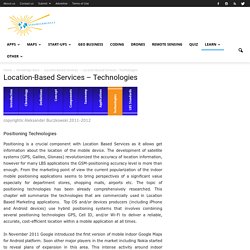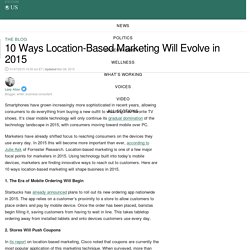

Location-Based Services - Technologies. Copyrights:Aleksander Buczkowski 2011-2012 Positioning Technologies Positioning is a crucial component with Location Based Services as it allows get information about the location of the mobile device.

The development of satellite systems (GPS, Galileo, Glonass) revolutionized the accuracy of location information, however for many LBS applications the GSM-positioning accuracy level is more than enough. From the marketing point of view the current popularization of the indoor mobile positioning applications seems to bring perspectives of a significant value especially for department stores, shopping malls, airports etc. The topic of positioning technologies has been already comprehensively researched. In November 2011 Google introduced the first version of mobile indoor Google Maps for Android platform. Cell ID The Cell ID (or Cell-of- origin) is the simplest localization method available in cellular networks. Enhanced Cell ID Global Positioning System (GPS) Assisted GPS (A-GPS) Geofencing. It's Time to Wire Your Business for Indoor Location-Based Search.
Indoor location-based search (LBS) is growing as a natural extension of location-based search and marketing.

According to a report by Mobile Marketing Watch (MMW), Americans spend more than 80 percent of their time indoors, and 85 percent of the mobile data generated is from indoor locations. The same report finds that by 2016, there will be more than 200,000 indoor locations across America featuring indoor LBS technology. This is an 800 percent increase over the present number of around 25,000. Big retailers such as Best Buy, Walgreens and Target have already implemented LBS. Related: 9 New Tips for Location-Based Marketing Shopkick, a LBS shopping app, alerts users to deals and discounts the moment the user walks into a store that is a part of the Shopkick network.
LBS allows people to locate products and services over a narrow area such as a mall, stadium, hospital, airport or retail store. Related: How Location-Based Marketing Can Help You Connect with Customers Limited Time Offer. 10 Ways Location-Based Marketing Will Evolve in 2015. Smartphones have grown increasingly more sophisticated in recent years, allowing consumers to do everything from buying a new outfit to watching their favorite TV shows.

It’s clear mobile technology will only continue its gradual domination of the technology landscape in 2015, with consumers moving toward mobile over PC. Marketers have already shifted focus to reaching consumers on the devices they use every day. In 2015 this will become more important than ever, according to Julie Ask of Forrester Research. Location-based marketing is one of a few major focal points for marketers in 2015.
Using technology built into today’s mobile devices, marketers are finding innovative ways to reach out to customers. 1. Starbucks has already announced plans to roll out its new ordering app nationwide in 2015. 2. In its report on location-based marketing, Cisco noted that coupons are currently the most popular application of this marketing technique. 3. Holding a big event? Top 4 Location-based Marketing Trends for 2016. Businesses are investing in location-based marketing strategies and location technologies to directly communicate with customers through their mobile devices.

This makes for a smart choice for two primary reasons: widespread adoption of smartphones and evolution of location-based technologies. Firstly, the global smartphone penetration per capita is on a rise from 9.6 percent in 2011 to 31.3 percent in 2016. Smartphone adoption continues to reach high numbers with an estimated 2 billion consumers worldwide expected to own a smartphone this year. With an increase in adoption, the use of smartphone has also evolved over time. For instance, 8 out of 10 consumers prefer to use smartphones in-store to make a purchase decision according to a study conducted by Google. Secondly, location-based technologies, such as iBeacon, are creating a lot of buzz given a large number of successful deployments by retailers worldwide. 2) Location-based technologies will gain strength on the security front. The future of location-based services.